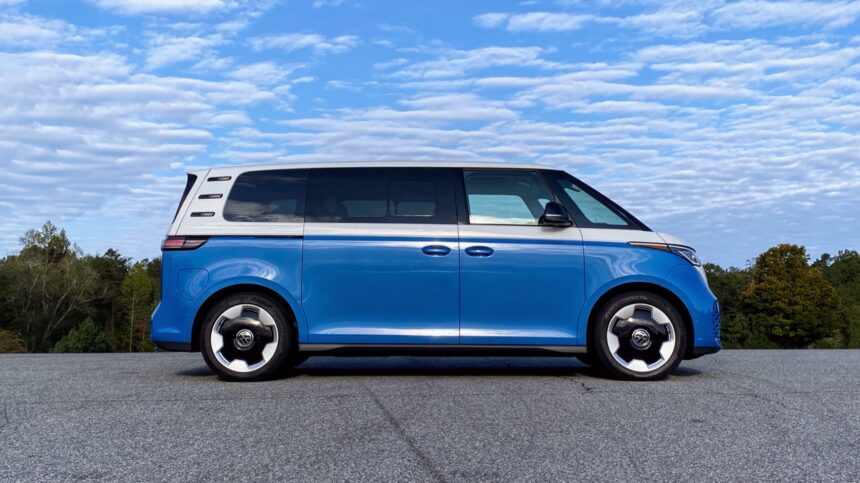Minivans have long been a staple for families needing space, comfort, and versatility. While their popularity has waned in recent years, the current crop of minivans on the market is better than ever. With the introduction of new electric and hybrid options, minivans are evolving to meet the demands of modern consumers.
One of the most anticipated new minivans is the 2025 Volkswagen ID.Buzz electric van. Set to revitalize the minivan market with battery power, the ID.Buzz joins three other minivans that offer hybrid or plug-in hybrid options. The Honda Odyssey, Toyota Sienna, Kia Sedona, and Chrysler Pacifica are all strong contenders in the segment, each offering unique features and capabilities.
The Honda Odyssey, a longstanding favorite in the minivan market, is a solid choice for families. With a range of trim levels and prices starting at $43,315, the Odyssey comes equipped with a 280-hp 3.5-liter V-6 engine and a 10-speed automatic transmission. While it lacks a hybrid powertrain option and only comes in front-wheel drive, the Odyssey stands out for its excellent handling and reliability. However, its infotainment and tech features lag behind competitors, prompting speculation about its future in the market.
On the other hand, the Chrysler Pacifica offers a mix of traditional and modern features. With prices starting at $41,690 for the Voyager trim, the Pacifica comes with a 287-hp 3.6-liter V-6 engine and a 9-speed automatic transmission. The standout feature of the Pacifica is its Stow ‘N Go seats that fold into the floor, providing unmatched versatility for families on the go. The Pacifica also offers a plug-in hybrid option with 32 miles of electric range, making it a fuel-efficient choice for eco-conscious consumers.
As minivans continue to evolve, consumers have more choices than ever before. Whether you prefer the classic styling of the Honda Odyssey or the innovative features of the Chrysler Pacifica, there’s a minivan out there to suit your family’s needs. With the introduction of electric and hybrid options, minivans are poised to make a comeback in the automotive market. The Pacifica PHEV is a standout option in the minivan market, especially considering its qualification for the full $7,500 federal EV tax credit. This means that depending on your income, the cost of the Pacifica PHEV could be nearly the same as the gas model. With this in mind, let’s take a closer look at some other top contenders in the minivan segment.
- Toyota Sienna:
The Toyota Sienna offers a standard hybrid option with impressive fuel efficiency, boasting 36 mpg combined with front-wheel drive and 35 mpg combined with all-wheel drive. While it may not have the same power as V-6 options in the class, the Sienna’s 245-hp inline-4 and two-motor hybrid system provide a stable and comfortable ride. The Sienna comes in six trims with various options, making it a practical choice for minivan owners. However, the second-row seats are not as versatile as other models in its class. The top trims can get expensive, but the Sienna offers practicality over luxury in its configurations. - Kia Carnival:
The Kia Carnival now offers a hybrid option, adding efficiency and refinement to its already impressive features. With a starting price of $37,895, the Carnival offers good value for its class. The hybrid model provides a fuel-efficient alternative, with a 242-hp 1.6-liter turbo-4 engine and a single motor. The Carnival excels in smart storage space, user-friendly infotainment interface, and an exceptional 5-year/60,000-mile warranty. While it may lack all-wheel drive and fold-in-the-floor seats, the Carnival stands out as a value play in the minivan segment. - Volkswagen ID. Buzz:
The Volkswagen ID. Buzz brings a new electric twist to the minivan segment, offering a sleek design and modern features. With a 282-hp single motor or 335-hp dual-motor all-wheel drive option, the ID. Buzz provides a range of up to 234 miles on a single charge. The spacious interior and clever storage options make it a practical choice for families. However, being made in Germany, the ID. Buzz does not qualify for a tax credit, making it a relatively expensive option compared to other minivans. Despite this, the ID. Buzz stands out for its clean and modern design, pushing the minivan segment forward into the electric age.In conclusion, the minivan market offers a range of options for families looking for practicality, efficiency, and modern features. Whether you opt for the Pacifica PHEV, Toyota Sienna, Kia Carnival, or Volkswagen ID. Buzz, there is a minivan to suit your needs and preferences. Consider factors such as fuel efficiency, powertrain options, pricing, and standout features when choosing the best minivan for your family. The Evolution of Artificial Intelligence: From Basic Algorithms to Advanced Machine Learning Models
Artificial Intelligence (AI) has come a long way since its inception, evolving from basic algorithms to advanced machine learning models that can perform complex tasks with incredible accuracy. The rapid advancements in AI have revolutionized various industries, including healthcare, finance, and transportation, making it an indispensable tool for businesses looking to gain a competitive edge in today’s digital age.
The journey of AI began in the 1950s with the development of simple algorithms that could perform basic tasks such as solving mathematical problems or playing games like chess. These early AI systems were based on rule-based logic and required a lot of manual coding to perform even the simplest tasks. As a result, they were limited in their capabilities and could not adapt to new scenarios or learn from experience.
However, the field of AI took a major leap forward in the 1980s with the introduction of machine learning algorithms, which allowed computers to learn from data and improve their performance over time. This marked the beginning of a new era in AI research, as scientists began developing more sophisticated models that could analyze large datasets, recognize patterns, and make predictions with a high degree of accuracy.
One of the key milestones in the evolution of AI was the development of deep learning algorithms, which are based on artificial neural networks inspired by the structure of the human brain. These models can learn complex patterns and relationships in data by processing multiple layers of information, leading to breakthroughs in image recognition, natural language processing, and other AI applications.
Today, advanced machine learning models such as deep learning have become the backbone of many AI systems, powering virtual assistants, self-driving cars, and predictive analytics tools that are transforming industries and driving innovation. These models are capable of performing tasks that were once thought to be impossible for computers, such as understanding human speech, generating creative content, and even diagnosing diseases with a high degree of accuracy.
As AI continues to evolve, researchers are exploring new frontiers in the field, such as reinforcement learning, which enables machines to learn through trial and error by interacting with their environment. This approach has led to the development of AI systems that can play complex games like Go at a superhuman level and control autonomous robots in real-world scenarios.
Looking ahead, the future of AI promises even greater advancements, with researchers working on developing AI systems that can reason, plan, and understand the nuances of human behavior. These efforts are aimed at creating AI models that can truly mimic human intelligence and perform a wide range of tasks in a variety of domains, from healthcare and education to finance and entertainment.
In conclusion, the evolution of artificial intelligence from basic algorithms to advanced machine learning models has been a remarkable journey that has revolutionized the way we live and work. With continued research and innovation, AI has the potential to transform society in ways we have yet to imagine, opening up new possibilities for human-machine collaboration and ushering in a new era of technological progress.







